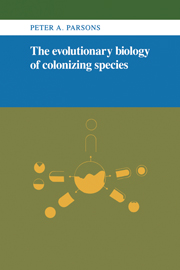Book contents
- Frontmatter
- Contents
- Preface
- 1 Introduction: Colonists and habitats
- 2 Genetics and ecology
- 3 Physical conditions, resources, and ecological phenotypes
- 4 Variability in natural populations
- 5 Genetic variability, ecological phenotypes, and stressful environments
- 6 Colonizing phenotypes and genotypes
- 7 Behavioral variability in natural populations
- 8 Habitat selection
- 9 The ecobehavioral phenotype: generalists and specialists
- 10 The ecobehavioral phenotype: biological control and domestication
- 11 Parasites and plants
- 12 Discussion and conclusions
- Appendix The study of quantitative traits
- References
- Index
11 - Parasites and plants
Published online by Cambridge University Press: 15 September 2009
- Frontmatter
- Contents
- Preface
- 1 Introduction: Colonists and habitats
- 2 Genetics and ecology
- 3 Physical conditions, resources, and ecological phenotypes
- 4 Variability in natural populations
- 5 Genetic variability, ecological phenotypes, and stressful environments
- 6 Colonizing phenotypes and genotypes
- 7 Behavioral variability in natural populations
- 8 Habitat selection
- 9 The ecobehavioral phenotype: generalists and specialists
- 10 The ecobehavioral phenotype: biological control and domestication
- 11 Parasites and plants
- 12 Discussion and conclusions
- Appendix The study of quantitative traits
- References
- Index
Summary
Lewontin: Yes, in other words, you are always colonizing, but you grow so large so fast that you knock yourself out. Mayr: Your arc goes sky high. Lewontin: There is a sort of parasitic ability to colonize.
[Discussion at end of Lewontin (1965:94).]Successful colonizing species are distributed in many different families and they represent great diversity with respect to morphological and physiological characteristics. There is, however, one feature which the great majority of these notably successful colonizers share: a mating system involving predominant self-fertilization.
[Allard (1965:49) writing on plants.]Parasites
About three-quarters of the known animals on earth are insects. Of these, at least 60% are parasites (Table 1.1). An estimate that parasitic insects represent close to half the animals on earth does not, therefore, seem unrealistic (Price, 1980). Adding to these the large groups of parasitic animals found among the nematodes, flatworms, mites, and protozoa, it is clear that the parasitic way of life is more common than all other feeding methods.
Parasites have a negative impact upon their hosts, which act as the environment for the parasite, as repeatedly pointed out by parasitologists and others. The host reacts defensively and individually over the short term to the impact of the parasite (e.g., immune responses) and over the long term as a population coevolving with its parasite population. Therefore, at the genetic level coevolutionary phenomena are very important. Short generation times and large populations of parasites compared with the hosts permit a very precise tracking by the parasites of the genotypes controlling resistance in the host.
- Type
- Chapter
- Information
- The Evolutionary Biology of Colonizing Species , pp. 191 - 205Publisher: Cambridge University PressPrint publication year: 1983



